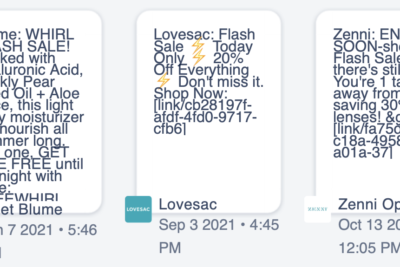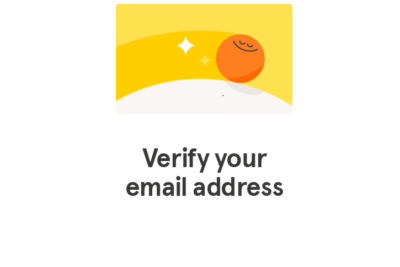Welcome to 2021! No matter what changes this new year might bring for your business or your ecommerce email program, you can count on MailCharts to keep monitoring ecommerce for you and bring you new data, email journeys and examples to help you become a more effective email marketer.
Right now, we’re adding new brands to our database, triggering and tracking more journeys and curating the best email examples you can use to keep tabs on your competition and get creative and strategic inspiration with just a few clicks.
We also track, analyze and report on data that you can use to build your 2021 strategic plan – everything from the volume and frequency of the brands you care about most to the ways brands use automations to connect with their most valuable customers.
Keep reading to see what’s new in this New Year. May it be the most prosperous one yet for you!
2020 in review
You might be ready to shut the door on 2020, but a quick look back over the last 12 months shows email came back into the spotlight. We track email activity in the 100+ brands curated into our MailCharts Index, and here’s what we found.
Apparel leads in weekly send volume

Apparel faced a major challenge in 2020, with consumers either working from home instead of going to the office, or staying home instead of going out and partying. That cleared the way for “athleisure” – relaxed clothing to wear around the house but stylish enough to wear for venturing out to the store.
Not surprisingly, then, Apparel was the busiest of the six industry groups in the Index, with brands sending an average 5.8 emails weekly.
Home brands boost promotion rates

While clothing sales cooled off, home brands including do-it-yourself stores, furniture retailers, interior design and home accessories took off in 2020. Email campaigns sent by brands in the Home industry group had an average promotion rate of 66%.
Email continued to reign as a bargain-hunter’s paradise for average promotion rates, as they exceeded 50% in four of the six core industry groups in the Index. The exceptions were brands that thrived in the economic straits of 2020: beauty and sports.
Home brands have longest subject lines

We track subject line length because it indicates how brands vary in the ways they use the subject line to prompt recipients to open the email. Here we see that the brands in our industry groups don’t vary much in their subject-line approaches, with just 12 characters (roughly two short words and a space) separating the longest and shortest average line lengths.
Although email experts debate whether longer or shorter subject lines work better, everyone agrees that you should put your most important information at the start of the subject line so your recipients will see it, even if their inboxes show only the first 30 to 50 subject lines. With that rule in mind, we see that the six core brands are following this best-practice advice.
What’s new in the MailCharts Index
MailCharts makes it easy for you to keep tabs on hot brands like these four. Just click on the brand and choose “Add [brand] to Group” on the overview page. (It’s the big blue button on the right side of the page.) Add it to your tracked brands or a special group of your own. So easy!
New brands
Check out these new additions to our database and consider adding to your custom tracking list:
- Wiggle (Sports & Activities)
- Boozy (Wine & Spirits)
- Evo Cycles (Outdoor)
- Cashmere Hair (Beauty & Personal Care)
New journeys
Tracking a brand’s automated email messaging is like peeking into its strategic playbook. You can see how it uses data to engage, persuade and retain customers. See how the seven email journeys listed below match up with key points on your customer’s journey with your brand.
Booking abandonment
Emirates is one of the airline brands emphasizing safety and relieving anxiety as a way to persuade travelers to get back into the air. Its booking reminder includes detailed safety and flight information to encourage passengers to click and complete their bookings.
Browse abandonment/back in stock
If a customer breaks off a browse session because his product is sold out, a back-in-stock reminder like this one from Watches.com could lure him right back. It uses excitement (“Look who’s back!”) and urgency (“Shop now before we run out again”) and adds personalized recommendations in case he hesitates again.
Cart abandonment
Cart abandonment is a year-round problem. Your abandoned-cart emails need to keep working hard, especially because your customers might not be under the same pressure to complete the transaction as they do during the holiday gift-giving season. Skis.com sends two emails within 72 hours after abandonment and offers two popular inducements: free shipping and a 10% discount.
Loyalty and rewards clubs
You brought in tons of new customers in your 2020 holiday campaigns. Now invite them to join your loyalty or rewards program to keep them engaged and buying again and again. Nine West‘s new-customer onboarding program (4 emails in 2 days) includes an email with a quick list of perks and points they earned just for joining.
Onboarding
GrubHub‘s onboarding email journey (3 emails in 3 days) combines bold colors and helpful copy. The bold color block at the top of each email aims to persuade the new customer to use the incentive and start ordering. The onboarding copy below it shifts with each email, from how to get started to the benefits of using the app.
Purchase
The COVID-19 pandemic made digital believers out of many in-store-only shoppers. The emails you send post-purchase can help keep them in the fold. Kate Spade‘s 5-email purchase journey begins with a detailed receipt and ends 6 days later with a product review request. In between are purchase and shipping confirmations that keep customers informed, which builds trust and confidence in purchasing again.
Subscription abandonment
Mistobox, a coffee subscription service, sends 3 emails over 7 days to resolve customer questions and persuade abandoners to come back and order their first boxes. Each email serves a unique purpose. Email 1 comes from the founder and looks like a personal email. Email 2 uses social proof to resolve doubts, while Email 3 focuses on both its high ratings and a satisfaction guarantee.
Recently curated email examples
MailCharts’ curated lists can save you hours of research and help you discover all kinds of emails you might never have found on your own. What will you do with that extra time? Plow it right back into your ecommerce email marketing program, of course (with time left over for an extra coffee break?).
Need a quick shot of inspiration? Look through these email lists to find just the right one:
- Winback: Reach out to lapsed customers with email that gives them a reason to return.
- Leave a review: People value other people’s opinions. Send an email to persuade your satisfied customers to write you glowing recommendations.
- Return emails: A return email that reassures and informs can bring customers back to buy again, even if it didn’t work out the first time.
- Groundhog Day: MailCharts tracks dozens of holidays like this one! Check this list to find creative ways to stand out in the inbox all year long.
What’s coming in 2021 in the MailCharts Index?
We’ll continue to add new brands, track and analyze journeys and provide fresh data and insights based on the top email brands in our MailCharts Index. Look for new content in these and other areas:
- New triggered journeys: We’re busy triggering and classifying new journey emails every day. We’ll share our best new examples in the next update.
- Curated lists with new email examples: We update our curated email lists every day to keep the messages and data you see there fresh and relevant. Add our examples to your custom lists of tracked brands, industry groups and email lists — one of the many perks of being a MailCharts subscriber!
What can we track for you?
Got a new brand or triggered journey you’d like us to track? Just drop us a note. We’d love to hear from you!






